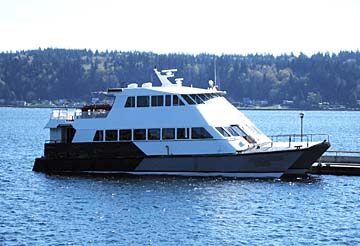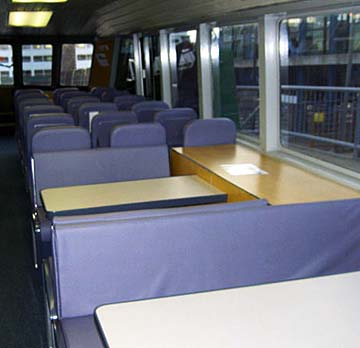
COURTESY BILL BRENNAN
The Rachel Marie, above, is one of two ferries that will carry passengers from Kalaeloa Harbor to Aloha Tower and back.
|
|
All aboard!
A test ferry from Honolulu to Waianae and points between begins Sept. 4
STORY SUMMARY »
The city is looking forward to the arrival this summer of Rachel Marie and Melissa Ann -- two 72-foot vessels that will ferry commuters between Kalaeloa and downtown Honolulu as part of a $6 million demonstration project.
Mayor Mufi Hannemann announced that the long-awaited one-year pilot intra-island ferry service will begin Sept. 4.
"We have been able to ink an agreement with (the Federal Transit Administration) for $3 million, so we can now move forward on preparing and operating our ferry demonstration project," Hannemann told reporters yesterday.
The 149-passenger ships, which will be operated by Hornblower Marine Services, are currently in Seattle and will make the journey to Honolulu beginning in mid-July. They are expected to arrive on Oahu in early August.
"It will take about a month to do the service prep, the training and of course to be U.S. Coast Guard-certified," Hannemann said.
City buses will shuttle passengers between Waianae Transit Center, Kapolei and Makakilo and the ferry pier in West Oahu. City buses will also transport passengers between the Aloha Tower pier downtown and the University of Hawaii and Waikiki via Ala Moana Center.
The cost to ride ferry service will be the same as the buses -- $2, including two transfers.
By ferry:
» Morning: Departures at 5:30 a.m., 6 a.m. and 8 a.m. The trip will take one hour.
» Afternoon: Departures from Aloha Tower at 4 p.m., 5 p.m. and 6:30 p.m. The return trip will take one hour.
By bus:
» To Kalaeloa Pier: Bus service from Waianae Transit Center, Villages of Kapolei and Makakilo.
» From Aloha Tower: Bus service to University of Hawaii and Waikiki via Ala Moana.
|
FULL STORY »

COURTESY BILL BRENNAN
The Rachel Marie, above, and Melissa Ann can each carry 149 passengers.
|
|
Success of the city's ferry service beyond the one-year demonstration period will likely depend on how many people ride, Mayor Mufi Hannemann said.
"I think basically we're going to have to demonstrate ridership, that we were able to basically utilize this as an opportunity to show another option for people to travel," the mayor told reporters yesterday. "I think (this is) a good earnest effort on our part to demonstrate that people now on the west side have another option in the morning and in the afternoon."
The project is already a year behind schedule. The city originally wanted to begin service last summer, but received no bidders for the contract.
After restructuring the contract, the start date was pushed back a couple of more times, and the city then aimed for a July start.
But the Federal Transit Administration held up approval of the $3 million grant over concerns relating to ridership and parking at the ferry pier in Kalaeloa.
Those concerns have been resolved, city officials said, and the new start date is Sept. 4.
The ferry service will have three runs in the morning and in the afternoon. Each vessel will be able to carry 149 passengers, with room also for 10 bicycles.
"If we can have the ferries operate at capacity each and every day, where it's basically we've got a standing-room-only type of situation -- that's the goal," Hannemann said.
In 1999, the state's Wiki Wiki demonstration ferry project began operation, but shut down after 14 months due to low ridership. Connection to city buses was not part of the plan, as it is with this one.
Hannemann said during the demonstration period, he will also look at ways to expand the service, including possibly having other stops at Iroquois Point and Ocean Pointe.
"In the future, I think what we're looking for is to see if we can make additional stops. We may also have to look in terms of more park and ride opportunities which is a longer term investment," the mayor said.
Said city Transportation Services Director Melvin Kaku: "It's our goal obviously that we would want to identify different areas and different markets of opportunity -- potentially there's the hotel workers, definitely people wanting to commute between downtown and Kapolei."
But with a one-hour travel time between piers -- not counting bus travel -- how will the city market the service to commuters?
"It's an opportunity for people not to use their vehicles," Hannemann said. "It really involves a change in behavior."
Members of the City Council are generally supportive of the ferry project, but have concerns about the future of the service.
"We need to run it for a long enough time a good idea of what its potential is," said Councilman Todd Apo, whose district includes Kalaeloa. "We also have to evaluate it knowing that this is a lifestyle practice that will change instantly."
"I'm not wildly optimistic that this thing is going to have a dramatic effect on traffic," Councilman Charles Djou said.

